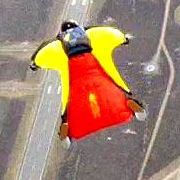JerryBaumchen 1,451
Back in the '60's Dan Poynter did some testing on glide angle of round canopies. He rigged up some Rube Goldberg device to determine the glide angle. Then he started jumping canopies with various mods; double L's, TU's, blow holes, etc. I think everything that he tested were 1.1's. He found that all of the canopies had the same glide angle, some just got to the ground faster (ouch ![]() ).
).
Jerry
billvon 3,090
Nope. But a boat doing 5 knots into a 6 knot current will still never be able to go upstream - but will be able to go downstream quite quickly. Likewise, a canopy's _groundspeed_ (which is what you care about, since you will only be in the air for X minutes under a given canopy after opening at 3000 feet) is affected by windspeed - even if it the canopy itself is just happily flying along.
>So canopy with the higher wing load covers more ground both ways.
Not really. A slow canopy in a strong wind (flying downwind) will have a more horizontal velocity vector, since you are adding a small downward vector (canopy glide angle) to a large horizontal vector (wind.)
Take an extreme. Assume a big round canopy that has ZERO drive but will take 10 minutes to descend 2000 feet in a 20fps wind. It will cover over 2 miles before reaching the ground. Now consider a 2.5:1 loaded canopy that will be on the ground in under a minute from 2000 feet. Is it going to be able to cover two miles? Probably not; it is descending too steeply, even in the strong wind.
A wise pilot will try to go to minimum sink rate if he wants to extend the glide on the heavily loaded canopy, because that way the wind contributes more to his total speed vector.
QuoteTake an extreme. Assume a big round canopy that has ZERO drive but will take 10 minutes to descend 2000 feet in a 20fps wind. It will cover over 2 miles before reaching the ground. Now consider a 2.5:1 loaded canopy that will be on the ground in under a minute from 2000 feet. Is it going to be able to cover two miles? Probably not; it is descending too steeply, even in the strong wind.
Apples to oranges? Big round canopy is not an airfoil, those two does not have the same trim. How do you want to compare glide if those canopies has nothing in common?
I was flying a formation with a Cobalt loaded 1.6. My wing man used a Sabre loaded <1.3. And we kept the formation for several hundred meters....




.thumb.jpg.4bb795e2eaf21b8b300039a5e1ec7f92.jpg)
>>>>>>>>>>>>>>>>>>>>>>>>>>>>>>>>>>>
That is because the heavier-loaded canopy is exposed to winds aloft for fewer minutes.
On the other end of the scale, a lightly-loaded canopy will travel farther downwind because it is exposed to the winds aloft for more minutes.
Think again! Does a boat knows if the water is still or moving? Aircrafts are flying relative to the winds.
A canopy is propelled by the gravitational field of the Earth and not the winds....
I might disagree with both of you.
Both wind and the motion of the canopy can be described by a Ground coverage is the horizontal projection of the addition of the wind and the motion vector.
Wing load affect just the [ url "http://en.wikipedia.org/wiki/Magnitude">magnitude of the motion of the canopy.
Higher wing load yields to bigger magnitude.
the magnitude of the wind can be considered as much as the magnitude of horizontal projection of the winds.
So canopy with the higher wing load covers more ground both ways.